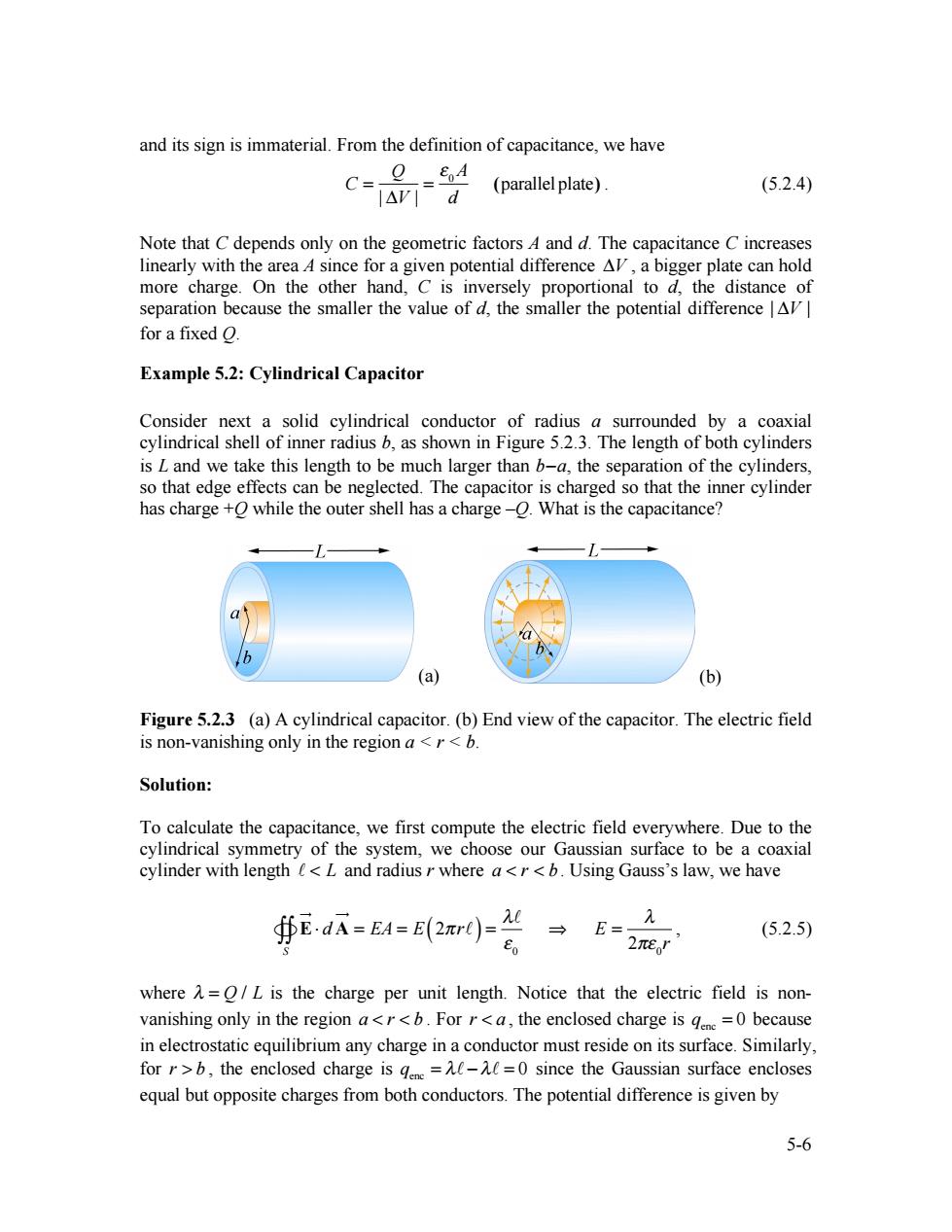正在加载图片...

and its sign is immaterial.From the definition of capacitance,we have C= 0-£oA (parallel plate). (5.2.4) |△Vd Note that C depends only on the geometric factors 4 and d.The capacitance C increases linearly with the area 4 since for a given potential difference Al,a bigger plate can hold more charge.On the other hand,C is inversely proportional to d,the distance of separation because the smaller the value of d,the smaller the potential difference Al for a fixed O. Example 5.2:Cylindrical Capacitor Consider next a solid cylindrical conductor of radius a surrounded by a coaxial cylindrical shell of inner radius b,as shown in Figure 5.2.3.The length of both cylinders is L and we take this length to be much larger than b-a,the separation of the cylinders, so that edge effects can be neglected.The capacitor is charged so that the inner cylinder has charge +O while the outer shell has a charge-O.What is the capacitance? (a) (b) Figure 5.2.3 (a)A cylindrical capacitor.(b)End view of the capacitor.The electric field is non-vanishing only in the region a <r<b. Solution: To calculate the capacitance,we first compute the electric field everywhere.Due to the cylindrical symmetry of the system,we choose our Gaussian surface to be a coaxial cylinder with length <L and radius r where a<r<b.Using Gauss's law,we have ∯EdA=EA=E(2r)=2L E=- (5.2.5) 2πer where =/L is the charge per unit length.Notice that the electric field is non- vanishing only in the region a<r<b.For r<a,the enclosed charge is =0 because in electrostatic equilibrium any charge in a conductor must reside on its surface.Similarly, for rb,the enclosed charge is ene==0 since the Gaussian surface encloses equal but opposite charges from both conductors.The potential difference is given by 5-65-6 and its sign is immaterial. From the definition of capacitance, we have C = Q | !V | = " 0A d (parallelplate) . (5.2.4) Note that C depends only on the geometric factors A and d. The capacitance C increases linearly with the area A since for a given potential difference !V , a bigger plate can hold more charge. On the other hand, C is inversely proportional to d, the distance of separation because the smaller the value of d, the smaller the potential difference | !V | for a fixed Q. Example 5.2: Cylindrical Capacitor Consider next a solid cylindrical conductor of radius a surrounded by a coaxial cylindrical shell of inner radius b, as shown in Figure 5.2.3. The length of both cylinders is L and we take this length to be much larger than b−a, the separation of the cylinders, so that edge effects can be neglected. The capacitor is charged so that the inner cylinder has charge +Q while the outer shell has a charge –Q. What is the capacitance? (a) (b) Figure 5.2.3 (a) A cylindrical capacitor. (b) End view of the capacitor. The electric field is non-vanishing only in the region a < r < b. Solution: To calculate the capacitance, we first compute the electric field everywhere. Due to the cylindrical symmetry of the system, we choose our Gaussian surface to be a coaxial cylinder with length ! < L and radius r where a < r < b . Using Gauss’s law, we have E !" ! d A !" S #"" = EA = E( 2#r! ) = $! % 0 & E = $ 2#% 0 r , (5.2.5) where ! = Q / L is the charge per unit length. Notice that the electric field is nonvanishing only in the region a < r < b . For r < a , the enclosed charge is enc q = 0 because in electrostatic equilibrium any charge in a conductor must reside on its surface. Similarly, for r > b , the enclosed charge is enc q = !! " !! = 0 since the Gaussian surface encloses equal but opposite charges from both conductors. The potential difference is given by